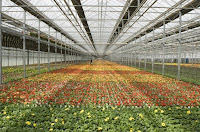 |
| Metrolina Greenhouses, which provides annuals to Lowe's and Home Depot |
I suppose that’s why I don’t shop for flowers at Big Box stores. I don’t want my choices limited by what a focus group determined was the most ‘cheerful’ daisy or the ‘friendliest’ shade of impatiens. In fact, I don’t want either those impatiens or daisies in my garden.
 |
| Andrew's Greenhouse is not quite as large, and focus groups don't appear to be involved. |
The catalyst for bringing up an article that appeared on April 27 is that Betty and I went shopping for flowers on Saturday. We ventured 170 miles round trip (with gas at $3.89 per gallon) in order to purchase some $200 of annuals (and a few perennials) from Andrew’s Greenhouse in South Amherst, Massachusetts. Why? Because we wanted plants that would cause people to sit up and take notice. We wanted plants that would ‘pop’ in containers. We wanted plants with sizzle.
It took two hours of meticulous comparison to find the annuals we wanted (or, to be completely truthful, that Betty wanted because she is the one who designs the containers into which these plant will go). We grouped cultivars looking for memorable color arcs and juxtaposing flower and leaf sizes and shapes. We endlessly examined individual plants seeking the one with the most buds and the best conformance.
 |
| Part of our haul from Andrew's. It will take abouttwo weeks to put together the first dozen or so containers. |
Yesterday evening, Betty began the process of assembling those purchases into containers. (Each container may be reconfigured half a dozen times and even a ‘final’ container is subject to editing.) The beauty of what we purchased became evident as she worked when the unusual bumped up against more common annuals to create a garden in a pot that will grow more interesting as the plants grow together. Not everyone would care for our choices. Anyone with the same group of plants would do the containers differently, that is the beauty of individuality. A beauty that I would believe is harder to imagination when all the plants have won the focus groups’ award of “least likely to offend”.










